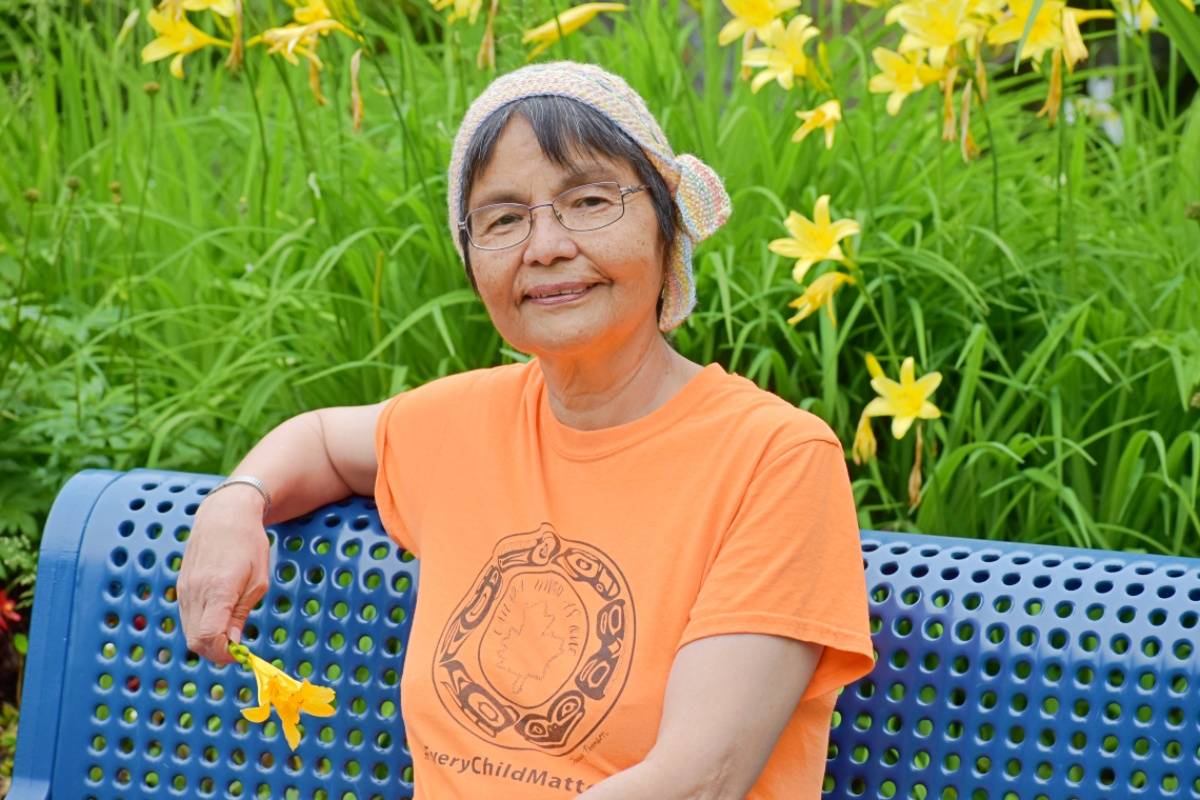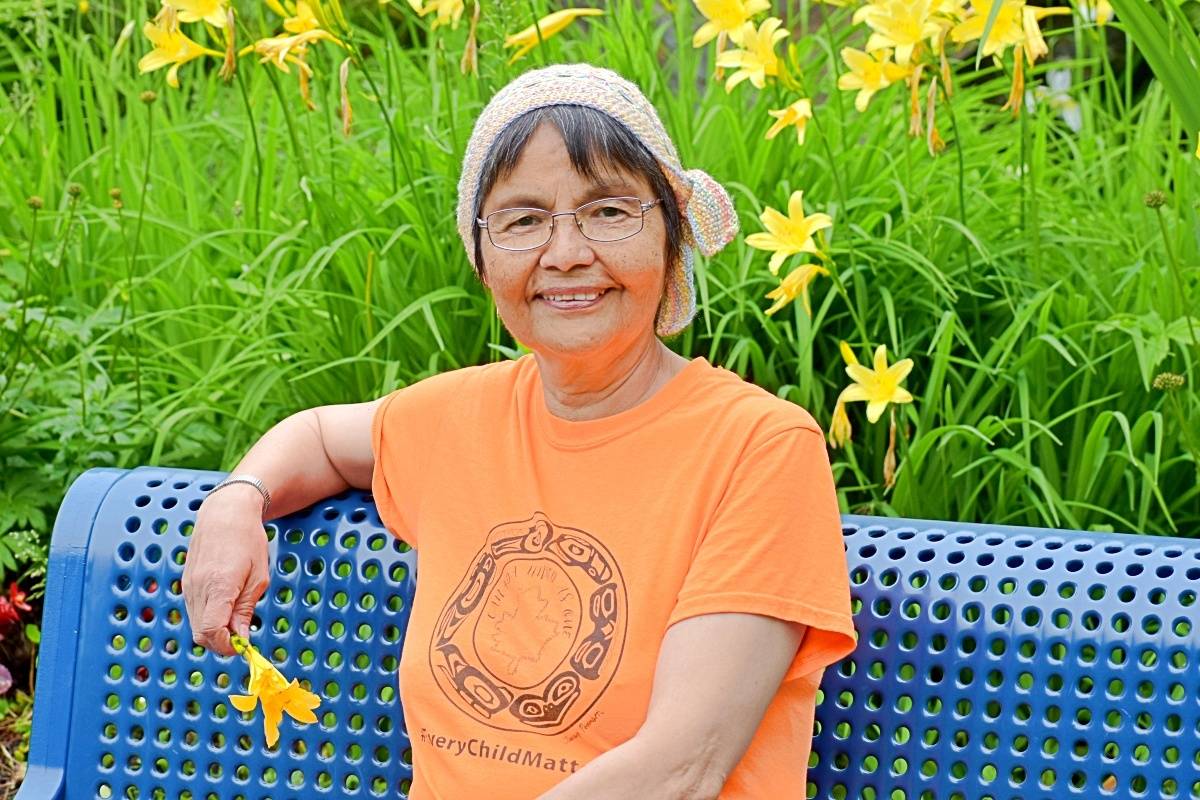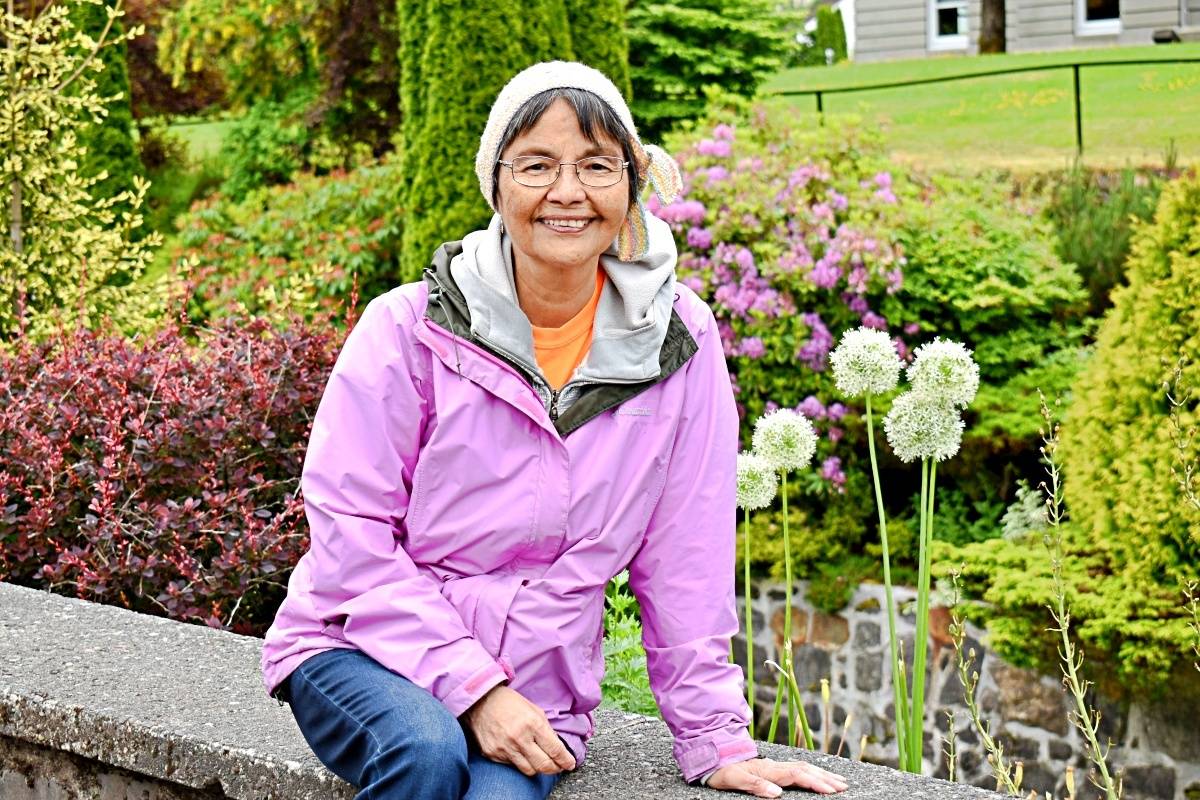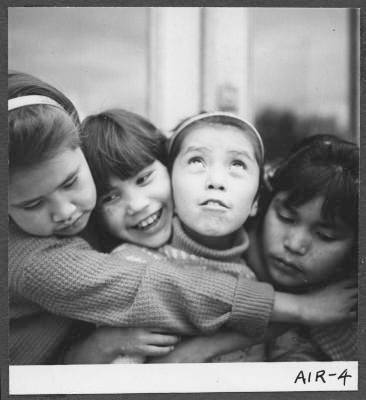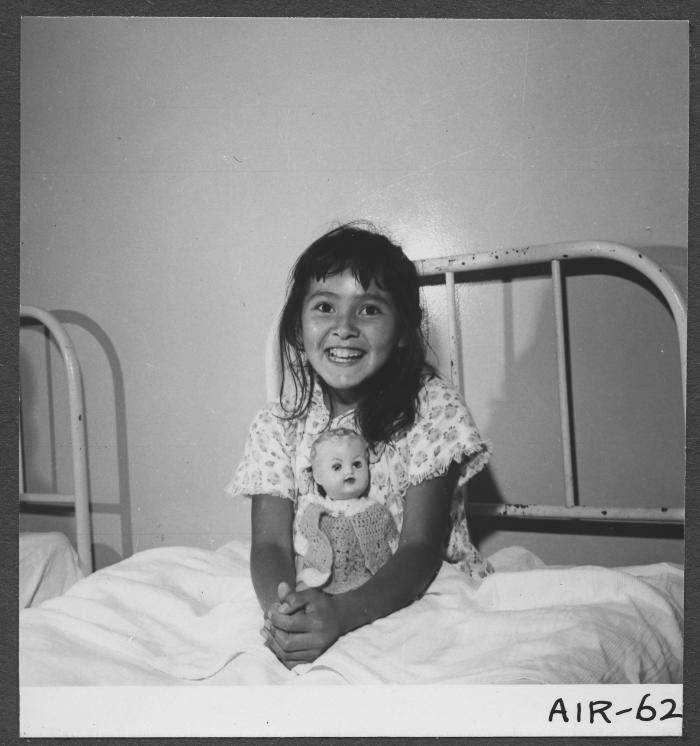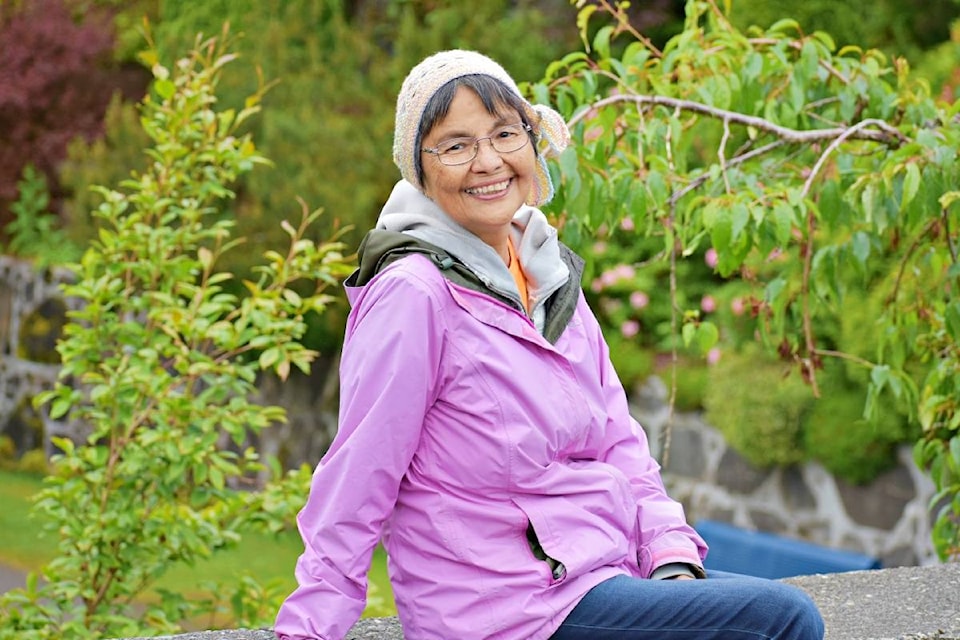“My name is Georgina Calder, before that Georgina Wesley, but I also used to be called Number 44. I’m so nervous to tell my story, but I have to get it out.”
“It’s taken me a week to get up the courage to come here,” she said as she sat down in The Northern View office, breathing heavily and kneading her hands. From safe social distance across my desk, I knew this was an interview I needed to be maskless for because she too was removing a mask of her past that predated the global pandemic.
She said her bed in the residential school where she spent years was numbered 44, her clothes were labelled number 44, and her name was discarded to be replaced with Number 44.
The young girl was a gifted child who attended Indian Day School in Port Simpson. Originally denied school enrollment because of her young age of five, her sister gifted a fish to the principal’s wife so Georgina could show her reading ability, which was a Grade 3 level. She was immediately placed in Grade 1. It was in day school that she first learned new names.
She was called names by the teacher, hit with a wooden yardstick, hit over the head with a bible for not understanding something. She was called ‘stupid Indian’ and made to stand in the corner with a dunce cap on.
“I didn’t know I was an Indian. I thought, why would you call me dumb Indian,” she said. “My sister who was in the same class spoke up and said she’s not a dumb Indian. Her name is Georgina.”
“My sister got hit with a long a stick like a yardstick.”
When her mother told Georgina and her four siblings they were going away, Georgina didn’t know where. She just knows that she was collected from the only home she knew by the local Indian agent, driven in his car to a bus in Prince Rupert which had no adults on it except the driver.
On the bus, she was not permitted to sit next to her siblings. She was not permitted to speak to them. The family eventually made its way to Port Alberni Indian Residential School (AIRS).
Her life before this defining moment at nine years old were early years spent with both her parents eating fish, reading books, and playing with other children in the small community.
In 1963, when Georgina and her siblings arrived at AIRS, the school was operated by the United Church of Canada. It was built in 1893 to be a Presbyterian girl’s home. The United Church purchased it in 1925.
According to the Truth and Reconciliation Committee, 30 children died at the school. In 1995, a former supervisor of the school was sentenced to 11 years in prison after being found guilty of committing 18 counts of indecent assault against indigenous students. The incidents occurred from 1948 to 1968.
Georgina said there were no nuns in her school but when they arrived at the front doors everything was taken from them. Their belongings were taken, their clothes were removed, their hair was shorn, and even their names were replaced. Georgina was told from that point on her new name was Number 44.
“Our chairs were marked. Our bed was marked. Everything was marked with our numbers,” she said.
She said it was very difficult for her to described how she felt at the time. She was so scared she ran away and hid when the girls had lice treatment and their culturally grown long black hair was shorn. She thinks a harsh chemical poison was used as lice treatment as she recalled seeing the letters DDT on the bottle of powder which was coated over their heads. She came out of hiding when the hair cutting was finished. Her hair was cut off two days later.
Georgina described a typical day when the girls would wake up and help the younger children to get dressed and use the washroom.
“We had to go brush our teeth with some sort of powder. I found out later it was baking powder,” she said. They were not allowed toothpaste and no dental care was provided to the children.
Research has been carried out by the University of Guelph’s Ian Mosby whose work focussed on food history in Canada. He found between 1942 and 1952 ‘leading experts’ in nutrition at the time, in conjunction with the Red Cross conducted studies on residential school children and First Nations communities. Many of the students were used as test subjects. They were denied food and health care treatment so studies on the effects of malnutrition could be carried out. Port Alberni Residential School students were part of those tests.
Cleaning the dorm room was left up to the students, who started the task before breakfast.
“When breakfast was ready, we’d all go down to the lower basement. Line up by our dorm number and wait until the doors opened for mealtime — they call it mealtime but it was just cereal or porridge,” she said.
“I was hungry all the time.”
After breakfast, the older students would be sent to help the younger ones.
“They [supervising staff] always made sure that they sent only the girls that didn’t have a relative in there. So, I would go and help a little five-year-old girl,” Georgina said. “She got strapped a lot because she always put her shoes on the wrong feet.”
Even though it had the title of a school, Georgina said there were no academics. The students, she refers to as fellow ‘inmates’, spent their days cleaning, and sewing.
“Grade fours did dishes … I was in Grade 3. We were taught how to keep our dorm clean. There was no janitor, so we would have to clean the windows and scrub the floors … older kids did laundry.”
After lunch, the children were allowed a scheduled playtime in the basement. While there were numerous dorms, the children were not permitted to intermingle with any from a dorm other than their own. Siblings were kept apart and not allowed to communicate or wave at each other for fear of physical repercussions.
She said at playtime they would walk around the school grounds playing with snakes in the bushes, or they would play tag, but they were never allowed to touch each other. Children learned to run with their arms by their sides.
“They would have to see our hands to make sure we’re not touching. We learned to run with our hands down or we’d get strapped because they’d say we’re touching that person,”.
After the outdoor play, they were expected to set the tables for dinner.
“Gosh,” Georgina sighed heavily as she recounted. “There were a lot of kids to set the table for. We had to help out in the dining area.”
The food was never good she said. There was never enough to eat.
“We’d have a small little piece of meat and rice mixed with something that I could never eat,” she said.
Children were taught to tell on each other for misdemeanours and what were considered wrongdoings that extended to toilet facility use. There was always someone watching ready to tell tales, she said.
“We could always tell who squealed on you when you’re in the washroom because that person would have an extra slice of bread.”
“We were taught number one and number two. We had to use one square of toilet paper for number one and two squares for number two.”
“If we use more then we’d get strapped. We’d get strapped if we had brown marks in our underwear,” she started to cry as she spoke. “We can’t clean ourselves with two squares.”
They had two different straps she said about the corporal punishment tools. Both were leather. One was longer and thinner, about 18 inches in length. It left stinging welts. The other was shorter and thicker, about 12 inches in length and around half an inch thick. Eventually, Georgina said she learned not to cry.
When she didn’t cry she would be strapped longer and harder.
In 1964, Georgina and another girl named Number 29, were set apart from the other students one day.
“They told us we’re going for a bus ride because we were well behaved. I was so happy — I earned this I figured. We went sightseeing and then they took us to the top of a hill.”
Standing on the top of the hill and looking out they were shown the devastation that occurred on March 28 after an earthquake and tsunami devastated the west coast.
Both girls were told their parents were dead.
“I believed them,” Georgina said.
The next day the girls were called to the supervisor’s office.
“There was a couple there. They had a big smile on their face. The supervisor said you’re going to your new home. We’re adopting you out. We never argued. The day before they told us our parents were dead.”
The adoption lasted only a day. The girls were not allowed to sit on the furniture and were forced to scrub the bathroom from top to bottom after using the toilet. They had to scrub the bathroom again after the man ‘adopting’ them used it, too. They had to return to sit on the floor when they were finished.
Not wanting to scrub the bathroom again, Georgina held on, but eventually, as a child sitting on the floor in the same place all day long, she wet the floor.
“That woman - she grabbed me by my hair. Pulled me out the door and into her vehicle. She put a box of cardboard and paper there for me to sit on,” Georgina said as her voice broke at the memory. “Number 29 was furious with me because they’ve taken us back to residential school.”
“[At the front doors] they told the supervisor there are pigs cleaner than these ones. We don’t like them. I was basically numb over. I was like a zombie. I didn’t cry no more. I didn’t care if I got strapped. I kept telling myself it doesn’t hurt.”
“The biggest punishment was not being able to see my siblings,” she said. There were only a couple of times she was allowed to see them. One of the days was when a camera crew came to the school. The children were not smiling for the camera crews. In an effort to document the happiness of the children at the school, the supervisors allowed children to be reunited with their siblings.
“To show how happy we are that we away from our families, that’s what I gather. They give me and my sister a skipping rope. We’d never had one. We took turns and were laughing. We were so happy.”
“When the camera crew was gone the skipping rope was taken away and we had to go back to our dorms again.”
Georgina said at Christmas time the children were each given one present labelled with their number.
“It was wrapped in Christmas wrap. I remember because I was so excited opening up a gift,” Georgina giggled and said, “I didn’t care that it was a naked doll. I got a present.”
The next day another ‘inmate’ and she were sitting on the floor playing when the toys were taken from them, she said. They were told the toys were not theirs.
“That’s what Boxing Day has always meant to me — that we have to put all of our stuff in a box and give it to the needy.”
In 1965, suddenly the five siblings were rounded up without explanation and returned to Prince Rupert. The youngsters were dropped off and left to find their parents. An argument, the first of many, ensued between Georgina and her brother when they were told they were going back to their family. Georgina was adamant their parents would not be found because they were dead.
Each child had changed in the school. They were no longer the close-knit family that got along. They each had grown a fighting spirit and demons from their individual experiences.
With nowhere to go, they approached the door of the Friendship House. The manager recognized Georgina and called her over by using her name, which she hadn’t heard in more than two years.
He gave the children food and beds for the night.
“That made me feel warm inside because he was this white man holding the door open for First Nations.”
The next morning, she woke up to hear her mother’s voice down the hallway. Her feet pounding the wooden floor with speed she ran into her mother’s open arms. The family huddle all fell to the ground-hugging each other in reunification and laughing with happiness, she said.
“The government said, I’m an Indian, I’m Indigenous, I’m an Aboriginal person, I’m First Nations,” she said. “I want people to introduce themselves to me by telling me the name their mother gave them and just call me by my name. That means a lot to me because I’ve been called so many names.”
My name is Georgina and I like that.”
